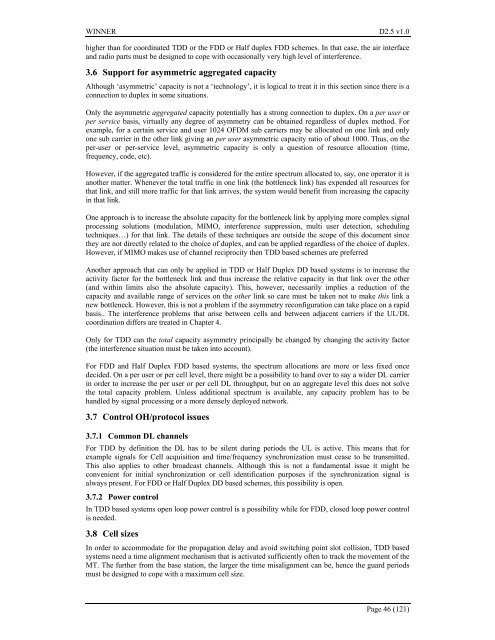IST-2003-507581 WINNER D2.5 v1.0 Duplex ... - Celtic-Plus
IST-2003-507581 WINNER D2.5 v1.0 Duplex ... - Celtic-Plus
IST-2003-507581 WINNER D2.5 v1.0 Duplex ... - Celtic-Plus
- No tags were found...
Create successful ePaper yourself
Turn your PDF publications into a flip-book with our unique Google optimized e-Paper software.
<strong>WINNER</strong> <strong>D2.5</strong> <strong>v1.0</strong>higher than for coordinated TDD or the FDD or Half duplex FDD schemes. In that case, the air interfaceand radio parts must be designed to cope with occasionally very high level of interference.3.6 Support for asymmetric aggregated capacityAlthough ‘asymmetric’ capacity is not a ‘technology’, it is logical to treat it in this section since there is aconnection to duplex in some situations.Only the asymmetric aggregated capacity potentially has a strong connection to duplex. On a per user orper service basis, virtually any degree of asymmetry can be obtained regardless of duplex method. Forexample, for a certain service and user 1024 OFDM sub carriers may be allocated on one link and onlyone sub carrier in the other link giving an per user asymmetric capacity ratio of about 1000. Thus, on theper-user or per-service level, asymmetric capacity is only a question of resource allocation (time,frequency, code, etc).However, if the aggregated traffic is considered for the entire spectrum allocated to, say, one operator it isanother matter. Whenever the total traffic in one link (the bottleneck link) has expended all resources forthat link, and still more traffic for that link arrives, the system would benefit from increasing the capacityin that link.One approach is to increase the absolute capacity for the bottleneck link by applying more complex signalprocessing solutions (modulation, MIMO, interference suppression, multi user detection, schedulingtechniques…) for that link. The details of these techniques are outside the scope of this document sincethey are not directly related to the choice of duplex, and can be applied regardless of the choice of duplex.However, if MIMO makes use of channel reciprocity then TDD based schemes are preferredAnother approach that can only be applied in TDD or Half <strong>Duplex</strong> DD based systems is to increase theactivity factor for the bottleneck link and thus increase the relative capacity in that link over the other(and within limits also the absolute capacity). This, however, necessarily implies a reduction of thecapacity and available range of services on the other link so care must be taken not to make this link anew bottleneck. However, this is not a problem if the asymmetry reconfiguration can take place on a rapidbasis.. The interference problems that arise between cells and between adjacent carriers if the UL/DLcoordination differs are treated in Chapter 4.Only for TDD can the total capacity asymmetry principally be changed by changing the activity factor(the interference situation must be taken into account).For FDD and Half <strong>Duplex</strong> FDD based systems, the spectrum allocations are more or less fixed oncedecided. On a per user or per cell level, there might be a possibility to hand over to say a wider DL carrierin order to increase the per user or per cell DL throughput, but on an aggregate level this does not solvethe total capacity problem. Unless additional spectrum is available, any capacity problem has to behandled by signal processing or a more densely deployed network.3.7 Control OH/protocol issues3.7.1 Common DL channelsFor TDD by definition the DL has to be silent during periods the UL is active. This means that forexample signals for Cell acquisition and time/frequency synchronization must cease to be transmitted.This also applies to other broadcast channels. Although this is not a fundamental issue it might beconvenient for initial synchronization or cell identification purposes if the synchronization signal isalways present. For FDD or Half <strong>Duplex</strong> DD based schemes, this possibility is open.3.7.2 Power controlIn TDD based systems open loop power control is a possibility while for FDD, closed loop power controlis needed.3.8 Cell sizesIn order to accommodate for the propagation delay and avoid switching point slot collision, TDD basedsystems need a time alignment mechanism that is activated sufficiently often to track the movement of theMT. The further from the base station, the larger the time misalignment can be, hence the guard periodsmust be designed to cope with a maximum cell size.Page 46 (121)
















